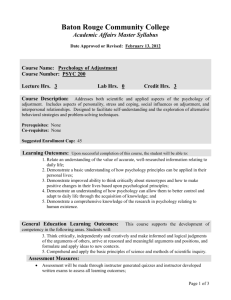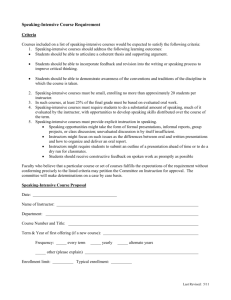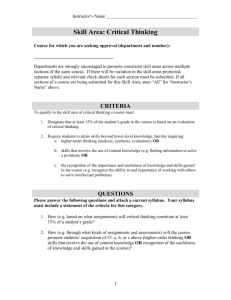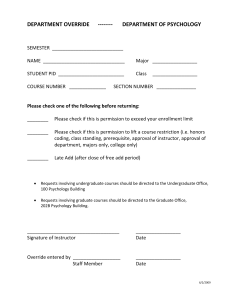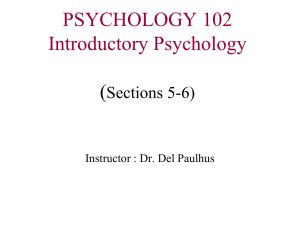REPORT - Psych 1 - Los Angeles Valley College
advertisement
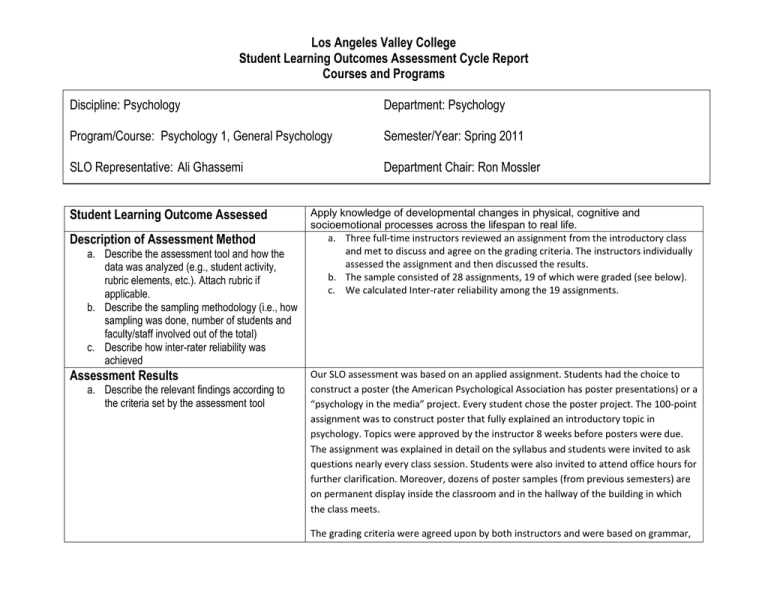
Los Angeles Valley College Student Learning Outcomes Assessment Cycle Report Courses and Programs Discipline: Psychology Department: Psychology Program/Course: Psychology 1, General Psychology Semester/Year: Spring 2011 SLO Representative: Ali Ghassemi Department Chair: Ron Mossler Student Learning Outcome Assessed Description of Assessment Method a. Describe the assessment tool and how the data was analyzed (e.g., student activity, rubric elements, etc.). Attach rubric if applicable. b. Describe the sampling methodology (i.e., how sampling was done, number of students and faculty/staff involved out of the total) c. Describe how inter-rater reliability was achieved Assessment Results a. Describe the relevant findings according to the criteria set by the assessment tool Apply knowledge of developmental changes in physical, cognitive and socioemotional processes across the lifespan to real life. a. Three full-time instructors reviewed an assignment from the introductory class and met to discuss and agree on the grading criteria. The instructors individually assessed the assignment and then discussed the results. b. The sample consisted of 28 assignments, 19 of which were graded (see below). c. We calculated Inter-rater reliability among the 19 assignments. Our SLO assessment was based on an applied assignment. Students had the choice to construct a poster (the American Psychological Association has poster presentations) or a “psychology in the media” project. Every student chose the poster project. The 100-point assignment was to construct poster that fully explained an introductory topic in psychology. Topics were approved by the instructor 8 weeks before posters were due. The assignment was explained in detail on the syllabus and students were invited to ask questions nearly every class session. Students were also invited to attend office hours for further clarification. Moreover, dozens of poster samples (from previous semesters) are on permanent display inside the classroom and in the hallway of the building in which the class meets. The grading criteria were agreed upon by both instructors and were based on grammar, content, presentation, and the student’s ability to respond fully to the assignment. Students were strongly encouraged to follow exemplary models and were given guidance on presentation in the syllabus, during class, by email, and during office hours. Students were also informed that the instructor would give feedback for content before it was incorporated into a poster. It was agreed that an A response (90/100) would have breadth of content, be free of multiple spelling and grammatical errors, be clean and organized, aligned, have appropriate graphics, and contain resources and references. An A response needed to give the reader a clear indication that the student understood the information and could give an informed “mini-lecture” on the subject. It was agreed that a B response would have a moderate to severe flaw in graphics, organization, or formatting OR have moderate flaw in content (including grammar and spelling), It was agreed that a C response would be topically accurate and contain moderate to severe flaws in at least two of the following areas: content (including grammar and spelling), graphics, organization, formatting OR show severe deficiency in content (including grammar and spelling), Overall, our SLO assessment for this class assignment resulted in a very high level of agreement and reliability on each student’s assignment. On a 100-point scale, instructors were within 9 points of each other in 18 out of 19 evaluations. One notable exception produced a discrepancy of 19 points. The instructor with more experience (i.e., has graded many from previous semesters) graded 14 of the 19 assignments lower than the other, perhaps reflecting degradation in quality from previous semesters. There was very high inter-rater reliability of .86. One problem was determining what constituted proper formatting and alignment. Presentations that were otherwise informative were sometimes unattractive. Perhaps the most problematic issue was related to plagiarism. Raters found nine instances of plagiarized information and therefore did not grade those assignments. How Results were Used for Course/Program Improvement a. Describe how the results are going to be used for the improvement of teaching, learning, or institutional effectiveness based on the data assessed. b. Describe how results will be shared with others in the discipline/area. After reviewing the results, the faculty then discussed additional ways to help students learn the desired outcome for the course. One idea that came up was the continued use of the English 28 advisory and how better to encourage students to take appropriate English courses prior to taking psychology classes; this would help students be more successful with their textbook readings, their understanding and comprehension of the material, and their assignments. English 101 would help students understand how to do research that would elevate understanding of poster topics, but formal research knowledge is not necessary. We also believe that the inability to simply follow directions had a major effect on grades. Many students were late to class, did not listen, did not read the syllabus, and/or did not avail themselves of class discussions online and during instructor office hours. We felt this lack of basic understanding permeated outcomes in general. In addition, the raters do not believe that the plagiarized posters were an aberration, though certainly it was unusual to have 25% on one assignment for one class. The syllabus was quite explicit and the instructor had frequently reviewed guidelines of plagiarism. We believe that academic dishonesy is an institutional problem that is not fully addressed campus-wide. Without extensive district (monetary) or campus (vigilance) participation, we are not sure how the problem of academic dishonesty can be fully addressed. Plagiarism continues to be a topic of discussion at department meetings.

